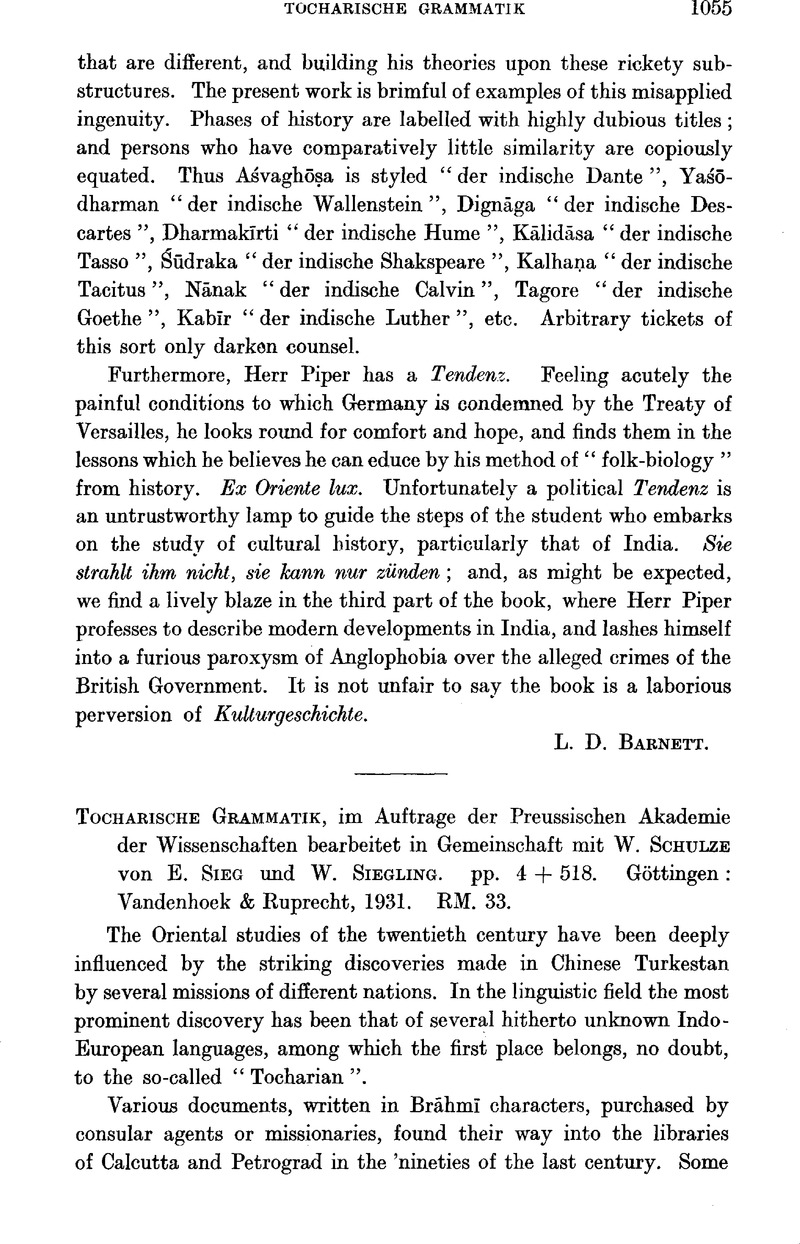No CrossRef data available.
Published online by Cambridge University Press: 24 December 2009

page 1056 note 1 “ Tocharisch, die Sprache der Indoskythen ”: Sitzber. Kgl. Preuss. Akad. Wiss., 1908, pp. 915–32.Google Scholar
page 1056 note 2 Sieg, E., “ Ein einheimischer Name fur Toχrī ”: Sitzber. Preuss. Akad. Wiss., 1918, pp. 560 sqq.Google Scholar
page 1057 note 1 “ Le groupement des dialectes Indo-Européens ”: Kgl. Dansk Vid. Selsk., H.-F. Med. xi, 3, Copenhague, 1925.Google Scholar
page 1058 note 1 Mémoires Soc. Linguist, de Paris, t. xvii, pp. 281 sqq.; t. xviii, pp. 1 sqq. and 381 sqq.
page 1058 note 2 k, ts > s, t > c, n > n, I > ly, s > ṣ; cf. Sitzber. Preuss. Akad. Wiss., 1924, pp. 167 sqq.+s,+t+>+c,+n+>+n,+I+>+ly,+s+>+ṣ;+cf.+Sitzber.+Preuss.+Akad.+Wiss.,+1924,+pp.+167+sqq.>Google Scholar
page 1059 note 1 Op. cit., p. 17, n. 1.
page 1059 note 2 Bemerkungen über die neuen Lautzeichen im Tocharischen, Helsingfors, 1925,§§ 4–7 sqq.Google Scholar
page 1059 note 3 “ Kuchean Studies. I. Indian Loan-words in Kuohcan”: Rocznik Orjentalistyczny, t. vi, Lwow, 1929, pp. 143 sqq.Google Scholar
page 1059 note 4 Reuter, , Die Anlautsvokale im Tocharischen, Helsingfors, 1924, p. 454Google Scholar; Pedersen, op. cit., pp. 25 sqq. passim.
page 1059 note 5 Cf. Toch. Sprachr., p. viii and n. 2.—The medial ṃ may, of course, represent ñ before palatals.
page 1061 note 1 Op. cit., §§ 2, 5: the names of animate beings ending in Skt. in -ă and -ā assume -e, -a in Kuchean, those of inanimates drop the final vowel (v. infra).
page 1061 note 2 Lévi-Meillet, , MSL. xviii, p. 385, 1. 2.Google Scholar
page 1061 note 3 Lévi-Meillet, ibid., pp. 381–2, a process that, in our opinion, has gone in Tocharian farther than in Kuchean (i.e. *ekuos, Kuch. yakwe, Toch. yuk).
page 1061 note 4 This case might go back to the i.e. ace. sing, in -m.
page 1061 note 5 This principle was first recognized by Smith, E., Tocharisch, etc., p. 31, Christiania, 1911Google Scholar, and later confirmed, for Kuchean, by Meillet, M., cf. MSL. xviii, p. 403.Google Scholar
page 1062 note 1 From √pik, pek “ to write, paint”, cf. Lat. pi-n-go, pictui, etc.
page 1062 note 2 The paper in question is not mentioned in the work we are reviewing where similar references are bv no means scarce.
page 1063 note 1 Cf. Kuchean Studies, Table 1 (p. 113), and § 2.
page 1063 note 2 Mār (═ Skt. Māra), usually in a compound, Mārnäkte ═ “ the god M.”, and Metrāk (Toch. Metrak), quoted by Sieg and Siegling, § 22.
page 1063 note 3 “ Bemerkungen zu den Brāhmīglossen des Tišastvustik-MS.”, p. 117, in Radloff, 's edition of the Tišastvustik, Bibl. Buddhica, xii, St. Petersburg, 1910.Google Scholar
page 1063 note 4 Kuch. St., pp. 160–1, § 36. The reviewer believed that the fluctuation of Karashahrian (═ Tocharian, v.s.) prevented this language from being regarded as the source; still the Mongol use of some names in -a without any vowel, like Kašip ═ Kāśyapa reminds of Karashahrian (Kāśyap).
page 1063 note 5 MSL. xviii, p. 420.
page 1064 note 1 MSL. xvii, pp. 281–94.
page 1066 note 1 MSL. xviii, p. 18.
page 1066 note 2 Ibid., p. 27.